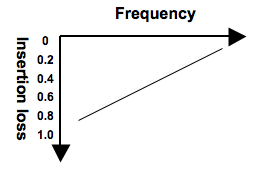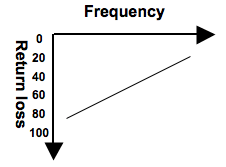VSWR
There is another characteristic which expresses the extent of the reflection : VSWR.
The closer the VSWR value is to 1, the lower the reflection and the better the characteristics.
VSWR is short for " voltage standing wave ration ". An increase in the frequency causes an increase in the reflection and an increase in the VSWR value.
The following formula shows the correlation between VSWR and return loss.
Examples) :
When VSWR is 1.1 = the return loss is approx. 26 dB
When VSWR is 1.2 = the return loss is approx. 21 dB
When VSWR is 1.5 = the return loss is approx. 14 dB
Characteristic impedance
In simple terms, impedance can be thought of as resistance. In a high-frequency circuit, it is like having many small resistors Zn aligned in the circuit.
If the resistance is the same for all of these resistors Zn in the circuit, the impedance will match, and there will be no signal reflection.
However, if it differs, reflection arises, making it impossible for the signals to be transferred reliably.
In a high-frequency circuit, the overall impedance of the circuit cannot be calculated by a process of addition as with simple resistors.
This means that when a relay with a characteristic impedance of 50 Ω is used in a 75 Ω type of high-frequency circuit the reflection will be increased.
This impedance is determined by the products in which the circuits are used and, in typical, it is 50 Ω or 75 Ω.
Examples)
50 Ω products : Communications equipment, test and measuring instruments
75 Ω products : TVs, CATV
In the case of relays, it is extremely difficult with today's technology to ensure perfect matching with a 50 Ω or 75 Ω system. Nevertheless, it is necessary to know which relays are closer to 50 Ω and which are closer to 75 Ω.
Microwave Devices Related Information










